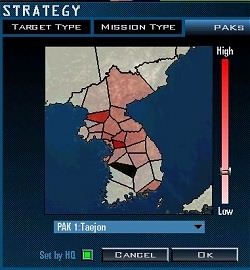| Low Altitude Flying for SAM Avoidance
by Spectre |
||||
|
After reviewing several ACMI tapes, and multiple crashes to the desktop, I have come upon several tactics for successful SAM avoidance. SAMs, as most of you well know, come in three distinct and deadly flavors. Radar guided, whether its CW (continuous wave) or TVM (track via missile), IR and Optical. Usually, optical guided SAMs are not really a separate SAM type but more of a back-up. More on that later. Radar SAMs are primarily long-range behemoths such as the SA-2, SA-3, SA-5 and the Patriot, to name a few. Originally designed to take out high altitude bombers, these missiles aren't really a threat to a nimble and modern aircraft such as the Viper, especially if it is flying NOE. IR missiles on the other hand pose a significant risk to the pilot, since they are usually low-altitude, high speed and quick reacting missiles. They were originally designed as close-in area defense for forward armored columns. In most cases, the pilot targeted has no warning of an IR SAM unless he or she spots the plume and/or the launch blast. Within the IR variants we have the man portables or "manpads" which, when utilized correctly, can cause severe distress to any aircraft pilot. Optical systems are encountered in almost every single variant of SAM systems. These are usually used as a back-up in case the primary guidance system fails or is jammed. Of course, a savy missile controller might try launching and guiding the SAM without any electronic assistance and therefore make a completely (theoretical) undetected attack. SAMs, when combined with AAA systems, make up the upper and middle air defense tiers of any air defense network. Long-range SAMs' are usually used to "bring down" high flying aircraft into a more lethal and larger air defense envelope. The famed SA-6 Gainful first used during the Yom Kippur War, caused havoc amongst Israeli fighters and managed to shoot down 23 IAF aircraft. But the weapon's true success came when it managed to lower the attacking aircraft's altitude so that they came into the envelope of Shilka and other weapon systems. This should be the primary concern of ANY fighter pilot when conducting CAS or any other close-in mud moving missions. He or she should constantly be aware of all potential weapon systems located throughout the area and plan accordingly. Rule number one: Once low, stay low. There are some SAMs which engage only when the pilot is either directly above the launcher, and in these cases you have to be extremely cautious especially when it's the SA-15. This SAM launches in volleys of two and I've begun to wonder whether one missile is launched in IR while the other is RH (radar homing). There are some indications that this may be the case, and in this situation the best course is to get low and fast at a 90 degree angle from the initial launch site. Remember that you'll be padlocked to one of the two initial missiles and if you are evading the first you'll probably still have the second on your tail. Caution here is essential to remain airborne. What about the other RH missiles? Most engage at their optimum range and therefore it is quite easy to detect and therefore padlock them, with ample warning. In Falcon 4 the SA-2, although the oldest missile, is the most effective. I wonder if this is a bug...? The SA-5 and the SA-3 are comparable to each other in performance, but I have noticed that wingmen are particularly vulnerable to the SA-5. The SA-6 has not been seen in the campaign but I am assuming that in the later stages of the campaign, i.e., when the Russians enter the fray, these missiles become more common, as for the SA-14 Gremlin (IR) which replaces the SA-7. Once you are low, look for ridgelines and small valleys into which you can drive your Viper. Keep the HST active since it'll give you an excellent idea as to where the threats are located and then you can plan your counterattack...or revenge if they get one of your wingmen. In the process remember that the HST displays currently radiating radars (in bold or highlighted numerals) and known but non-radiating sites (in darkened tones). Locked on sites are flashing and give you a good indication as to how the enemy site is doing. The same applies to AAA sites or mobile units such as the 2S6 and the Shilka. Stay low, unless you want to attract their attention. If you're the lone ranger then they'll be illuminating you and you alone and this makes things quite interesting. If you have a wingman, make him go high and cause the SAM sites to light up. Once he's engaged, make sure that you have the correct site and launch a HARM. Remember that you can launch the missile from any aspect angle but it's best to have the site within the frontal 180 degrees of your aircraft. This will in effect increase your missile's range. If you can, and you're under no threat, gain some altitude to help the missile out. |
 Against the SA-7, I recommend diving towards it while dumping flares. I have noticed in ACMI files that the SA-7 flys one of the most aggressive lead pursuit curves within the game, so you HAVE to padlock fast and start moving. You'll know that its a manpad since your pilot will say something like "SAM launch. West xxx degrees", or something of that nature. This is for your OWN personal information unless the sim is mimicking the general warning pilots call out whenever they see a SAM launch. When you hear this, hit the '4' key and see if you can padlock it. If you can, then MOVE fast towards it and descend as fast and as low as you can. Please note that this will take you back towards the soldier who just launched the missile and I don't have any reliable information as to what the reload times are...or whether the guy is alone...! If you have more than one of these things going for your burner, then you're in some DS (deep shit)... If these things are coming from different angles you have to realize that if you turn in any direction to negate the advantage of one, the other will be in an advantageous position. What to do? Get low and stay low. Try to fly behind cover. Rule number two applies here: LOS CAN be broken by ridgelines.
I've seen many a missile in F4, whether manpads or mobile, slam into the ground when the LOS was lost. It's quite an exilarating experience cause you know you beat the bastards and now it'll be your turn to hunt them down. :-) Just don't commit the mistake of popping up too early... Conclusion Practice. That's the ONLY key which I recommend my readers. You've heard that word applied to the landing practice but it still applies more to SAM avoidance and in my opinion even more so... Tape yourself constantly and especially whenever you fly SEAD or Strike Escort missions. The Instant Action mud moving scenario is quite excellent to test your skills, since it randomizes the enemy's starting positions and their air defense units. Sometimes they'll be in the same place BUT they change the type so you'll never be flying the same defensive maneuvers. After the mission, whether good or bad, STUDY those tapes since they give you excellent insight as to how the sites react to your presence and how they launch their missiles. Watch how the missiles fly towards your aircraft and in particular how they gain altitude and start flying their lead pursuit curve. I've been quite amazed in the flight geometry of these weapons as well as my own. A good tip is to observe how and when the manpads launch. You'll notice that 90% of the time they wait until you overfly them (which is realistic). Gives great insight as to when to padlock and move... Hope this FAQ file helps out a bit. I'm always open to comments and revisions to my theories. If you have something that you would like mentioned, please drop me a line at Spectre. Note: this article based on the patched version: Falcon 4.0104.
|
|||
|
© 1997 - 2000 COMBATSIM.COM, INC. All Rights Reserved. Last Updated February 16th, 1999 |
||||

